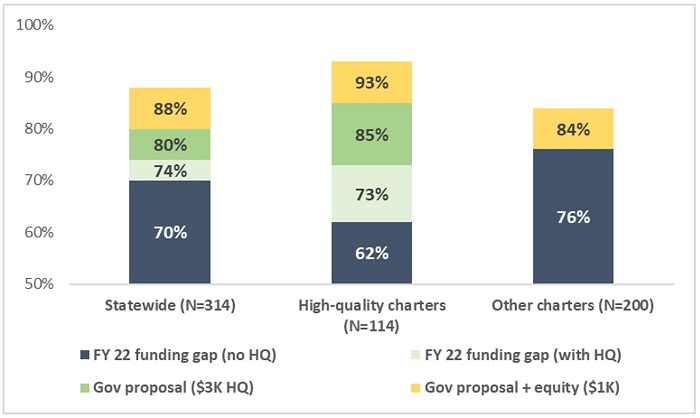NOTE: This morning, the Ohio Senate Finance Committee heard testimony on Substitute House Bill 33, the state’s budget bill for fiscal years 2024 and 2025. Fordham’s Ohio Research Director provided this written testimony on important provisions of the bill as amended in committee.
My name is Aaron Churchill, and I am the Ohio Research Director at the Thomas B. Fordham Institute. The Fordham Institute is an education-focused nonprofit that conducts research, analysis, and policy advocacy with offices in Columbus, Dayton, and Washington, D.C. Our Dayton office, through the affiliated Thomas B. Fordham Foundation, is also a community (charter) school sponsor. Thank you for the opportunity to provide written testimony on Substitute House Bill 33, the state’s biennial budget bill for fiscal years 2024 and 2025.
In this year’s budget bill, Governor DeWine and House lawmakers have made K–12 education a top priority. We’re pleased to see that the Senate has also done so. Taken together, the proposals in the budget will put more students on pathways to success in career, citizenship, and in life.
Let me first highlight several key policy reforms that are included in the Senate’s version of the budget and which Fordham strongly supports.
- Governance reform: The Senate budget would move Ohio to a more coherent, accountable governance system at the state level. It will better ensure that the state education chief and the state education agency are accountable to the governor and the General Assembly—and not functioning as a “fourth branch” of government that can weaken education laws through lackluster implementation.
- Science of reading: Every child should be taught to read using proven and effective instructional methods. Led by the governor, the budget bill would ensure that all elementary schools implement high-quality curricula aligned to the science of reading. In another critical step, the legislation also requires teacher preparation programs to adequately train Ohio’s future teachers in the reading science.
- Third grade retention: We strongly support the Senate’s removal of an earlier provision that would walk back the third grade retention requirement. Children with severe reading deficiencies need additional time and intensive interventions that help them catch-up. Consistent with studies from other states, a recent Ohio analysis shows that students retained under the Third Grade Reading Guarantee make significant gains compared to very similar students who just narrowly pass.[1] If the checkpoint goes away, so will the guaranteed supports for struggling readers. Instead, they’ll continue to flounder and some will eventually drop out.
- Career-technical education (CTE): The state’s investments in high-quality CTE should open great career opportunities for students while also benefitting employers seeking skilled workers. We’re especially pleased to see incentive funding for in-demand credentials and work-based learning included in the budget.
- School transportation: Thousands of students across the state have struggled to get to school on time due to broken transportation systems. The Senate is to be commended for proposing initiatives to address the ongoing concerns. Among them include: changes to the process of determining which students are impractical to transport, an increase in the payment in lieu of transportation, and allowing flexibility for smaller buses and vans.
- EdChoice eligibility: Ohio parents have the right—and responsibility—to direct the upbringing of their children. State-funded scholarships have long helped low- and middle-income families access private schools they believe work best for their children. We commend the Senate for expanding this benefit to all Ohio families, but in a responsible and equitable manner that ensures the bulk of this funding continues to support those most in need of the assistance.
- Timely provision of test scores: We applaud the Senate for including a provision that requires schools to provide parents with their child’s state exam results by June 30th. Without a deadline, many parents currently receive this information too late to take steps on behalf of their child.
- Guarantees: Ohio lawmakers have long struggled to root out guarantees—extraneous subsidies allocated to schools outside of the formula. To its credit, the Senate removes one of the most egregious guarantees in the current system—“supplemental targeted assistance”—which provides $53 million per year to a small number of districts that have historically had large numbers of students choose non-district options. This funding has nothing to do with the current enrollments or needs of these districts, and should be eliminated.
*****
Public charter schools: Equitable funding and accountability
Last, I’d like to touch on matters of charter school funding and accountability.
On the funding side, Ohio has historically left charter schools under-resourced, providing them with approximately 30 percent less per-pupil compared to local districts. Such a wide gap puts charter schools—and the students they serve—at a significant disadvantage. Without equitable funding, charters often struggle to provide extra supports and enrichment opportunities. They also face challenges in attracting and retaining talented teachers, as they’re left paying less competitive wages. Finally, the gap limits charters’ ability to expand and reach more Ohio students in need of a great education.
We at Fordham enthusiastically support the significant boost in funding for the Quality Community Schools program that the governor proposed and the House and Senate included in their budgets. In fact, the additional dollars will be a game changer for the one-third of charters that receive these funds, helping them expand and reach more students in need of a great education.
But even with this proposed increase, the average high-quality charter school would still fall well short of funding parity with local districts. Other brick-and-mortar charters would continue to face daunting funding gaps, as they receive no supplemental dollars at all. Many of these schools serve large numbers of low-income and special-education students; some focus on serving adolescents who have dropped out. To provide fairer funding for charter students, we ask you to support a $1,000 per pupil equity supplement for all brick-and-mortar charters, in addition to the increase for the high-quality charter fund. As Figure 1 below indicates, an equity supplement would bring charters overall to an average of 88 percent of the per-pupil funding of local districts. This more modest shortfall would track closely with the funding differentials in states with strong charter sectors such as Massachusetts and Texas.[2]
Figure 1: Impact of a charter school equity supplement[3]

As we ask you to spend additional dollars to bridge the funding gap, we also insist on strong accountability for results. One critical element of Ohio’s charter accountability framework is its sponsor evaluation system, which holds sponsors accountable for the performance of the schools they oversee. This system ensures that these entities, which allow charters to open and continue to operate, are focused on quality. It also encourages them to move quickly to close schools that are underperforming, and rigorously vet prospective startups. Strong measures at a sponsor level are likely a reason behind the steps forward in overall charter sector performance in recent years.[4] Paired with equitable funding, these rigorous charter accountability mechanisms will drive further improvements in the years ahead.
Parental empowerment, accountable school systems, strong literacy policies, and equitable and efficient funding can only help to increase student achievement. This budget bill focuses on these issues and it holds great promise for Ohio students and families.
Thank you again for the opportunity to submit written testimony.
[1] For a review of the Ohio study and those from other states, see: https://fordhaminstitute.org/ohio/commentary/more-evidence-time-ohio-third-grade-retention-works.
[3] More detail about these calculations is at: https://fordhaminstitute.org/ohio/commentary/ohio-narrowing-charter-funding-gap-it-still-needs-do-more.
[4] More about sponsors and charter accountability is at: https://fordhaminstitute.org/ohio/research/reinventing-ohios-charter-school-sector-2015-2023-ohios-successful-charter-turnaround.




